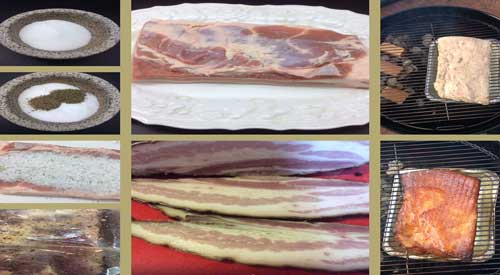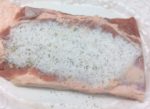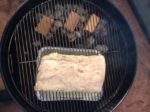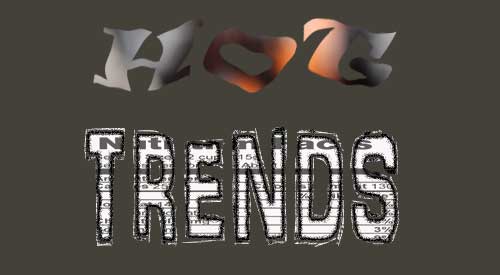Wed 11 Mar 2020
HOMEMADE SMOKED BACON
Posted by DrSmokeRead other related stories: Cooking , Cooking With Wood , General Smoking Information , Recipes , Smoking with chunks
No Comments

Steps to make Homemade smoked Bacon

Just about everyone I know loves bacon, even if it’s the store-bought type. There are so many foods that have been designed around bacon including a chocolate chip cookie recipe featuring caramelized bacon pieces and a bacon ice cream! (which we’ll offer a recipe for soon).
One thing most bacon lovers don’t know is just how easy it is to make your own bacon at home, even the smoked type. You’ll be amazed at how different the taste and texture are with bacon you make at home. Just know, my technique will require you to cure the pork belly for a minimum of 7 days so be sure you have refrigerator room and time to wait. I know – when it comes to bacon it’s sooooo hard! But it will be worth the wait!
Quality Meat a Must for Homemade Smoked Bacon

#porkbelly
When making homemade bacon, you’ll need a slab of pork belly, which is a relatively inexpensive cut of pork. Since this process is a time investment, consider purchasing a quality cut of belly which would be labeled “organic”. This cut normally comes from heritage breeds like Kurobuta and Berkshire. This investment will result in richer, meatier, and cleaner flavors to the finished product.
Although a full pork belly will weigh around 12 lbs., you only need about 3 lbs. to give you a sizeable quantity of bacon. Also, some belly will come with the skin still intact while others will already have the skin removed. Note, you will need to remove the skin before curing so you likely will want to ask the butcher to do this for you. If you’re doing skin removal yourself, simply separate the skin from the fat layer at one corner by inserting a knife point. Grab hold of the skin and begin making horizontal cuts with the knife in short sections, pulling the skin back as you go. Leave as much fat layer as you can. Once removed, it’s time to rub and cure.
Homemade Smoked Bacon- Rub and Cure to Flavor
Curing is preserving the meat. This is done not only by the ingredients in our rub but also by the process of hot smoking which contains antimicrobial benefits. Remember, when we are done with the smoking process, your bacon will be ready to eat as is, though you will be able to crisp it up if you want in a pan.
For my rub, I’ll be combining the following:
- 1 cup of maple sugar, coconut sugar or regular sugar
- ½ cup kosher salt
- 1 tablespoon cracked black peppercorn
- 2 teaspoons minced fresh thyme
- ¾ teaspoon pink salt also known as Prague Powder #1
- 1 crumbled bay leaf
- 1 teaspoon ground coriander

#briningporkbelly
Now cover every area of the pork belly with your rub. Place the rubbed pork belly in either a 13×9 baking dish covered with plastic wrap or in a storage bag. I prefer the jumbo size bags. Just be sure to remove all the air from the bag before sealing.
Place the belly in the refrigerator. Now starts the curing process. As it cures, the meat releases liquid. You’ll need to flip the meat every other day to ensure the cure is evenly distributed. Begin checking after 7 days if the belly is fully cured. You’ll know the pork belly is ready to be smoked when the meat feels firm to the touch but is still pliable. Rinse the pork belly under cold water to remove any excess cure or the outcome will be too salty. We are ready to smoke!
For Your Homemade Smoked Bacon- Make the Pork Belly Smoke!
Even if you don’t own a traditional smoker, you can still smoke the pork belly. Here’s the technique:
Charcoal Grill:
You will set up the charcoal grill using a two-zone cooking method. Start by loading about 3 lbs. of briquets or hardwood charcoal on one side of the charcoal fuel area. Place a water pan filled with water about 2-inches deep on the non-charcoal side. Then fill a chimney starter ½ full of briquets or hardwood charcoal. Lite and allow to burn to hot coals, then pour the hot coals over the top of the unlit charcoal in your charcoal grill. Add a couple of hardwood chunk pieces to the hot coals and allow to start smoking before you add the pork belly. Once the chunks are smoking, place the cured pork belly on the unlit side of the grate fat side up. Put the lid on and allow to smoke for about an hour without disturbing. Keep in mind, your intake vent should be open ½ way as well as the outtake vent at ½. A 3lb. pork belly will take about 1-1/2 to 2 hours to reach 150°F internal temperature. By using both hot and cold charcoal, you should not need to replenish the coal bed, just may need to add another chunk or two of hardwood.

#charcoalgrilling
Gas Grill:
Place a smoker box of small wood chunks directly on your heat shield or on the grill grate. Turn on only ½ the burners on your gas/LP grill and set to medium temperature setting. Place a small pan of water on the warming grate to keep a moisture rich environment during the cooking process. Allow the grill to reach 225°F and to have the wood chunks begin smoking. Place the cured pork belly fat side up on the unlit side of the grill. Allow the pork belly to cook until it reaches an internal temperature of 150°F. Replenish the wood chunks in the smoker box as needed.
Traditional Smoker:
Set up your smoker as normal targeting a 225°F cooking temperature. Be sure to include a water pan if your smoker doesn’t include one (a disposable foil pan works great). Again, use 2-3 hardwood wood chunks for the flavor. Place the pork belly fat side up and cook until the internal temperature reaches 150°F.
Homemade Smoked Bacon- Ready to Eat!
Once the pork belly has reached 150°F internal temperature, it is ready to eat as it is fully cooked! Remember, smoke has an antimicrobial quality which helps to make this consumable at this temperature level. I recommend you allow the bacon to cool to room temperature on a wire rack set over a sheet pan. Then wrap in plastic wrap and refrigerate for at least 4 hours. This will set all those great flavors.
By slicing it paper thin, you can consume this cold and enjoy a more prominent smoke flavor. However, you may pan fry this like traditional store-bought bacon or oven cook this on a rack over a foiled lined sheet pan for those who prefer a healthier, more rendered fat version. This method also allows you to do a lot more bacon at one time then pan frying allows.
Refrigerated homemade bacon will last 5-7 days while frozen will keep for several months. Once you sample your own homemade smoked bacon, you’ll never purchase prepackaged again!



